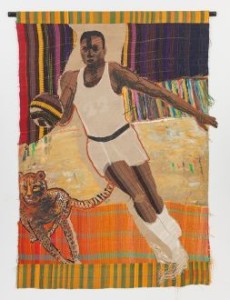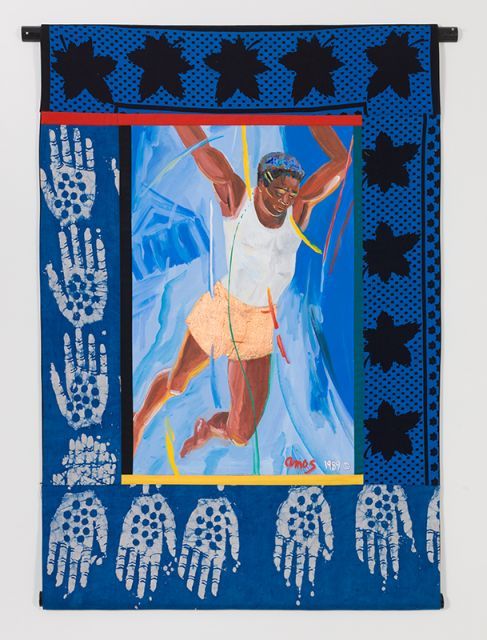
Emma Amos
Colors, Paintings of the 1980s
Until April 2, 2016
Ryan Lee Gallery, New York
22 and Cheetah, 1993.
About:
RYAN LEE is pleased to announce Emma Amos: True Colors, Paintings of the 1980s, a solo exhibition featuring works made by the important post-modernist artist during a critical period in her oeuvre. This is the first time that work from this decade has been exhibited in New York in more than 10 years.
On view is a selection of paintings in which Amos questions and reframes the figure and images of blackness through themes of movement, fragmentation, and tension. Intending to insert people of color and ideas of blackness into the canon from which it had long been withheld, Amos uses formal techniques that pull from movements notably associated with her white, male counterparts, such as Action Painting, Abstract Expressionism, and Color Field Painting. It is during this period that Emma introduces the figure in flux for the first time. She also continues her exploration of space and color evident in her 1960s and 1970s work, notions that are deeply tied to social, political, gender, and racial implications. It is as much about color theory, texture, perspective, and composition as it is about colorism and sexism, or where and how the black body was historically accepted or allowed to exist in art history.
Why we left the beach, 1987.
Divers, 1987.
Amos considers the black athlete and wild animals in her “Athletes and Animals” (1983-1985) series. Paralleling images of sports players with lions, cheetahs, and crocodiles, she suggests the fleeting and illusory power, both in physicality and influence, of the black athlete. “I want to make clear the relationships between artists, athletes, entertainers, and thinkers, and the prowess, ferocity, steadfastness, and dynamism of animals,” Amos told Lucy Lippard in 1989. Her transformative investigation into the depictions of the black body further extends to her representation of Josephine Baker, an important subject for the artist. Baker, who was politically vocal and arguably the most visible black entertainer of her time, stood as a new way to reconstruct blackness. Serving as an extension to these works, “The Falling Series” (1988) relates specifically to Amos’ own anxieties surrounding the erasure of history, place, and people. Amos also considered the economic crisis of the Reagan era and the abyss. She depicted dancers, singers, and other figures slipping, tumbling, and hurling through abstracted spaces among iconic and classic architecture, mythological motifs, and symbols of jazz and blues music.
The Raft, 1986.
Amos was the youngest and only woman member of Spiral, an historic artist collective founded in 1963 by Romare Bearden, whose 15 members also included Charles Alston, Alvin Hollingsworth, Norman Lewis, Merton D. Simpson, and Hale Woodruff. More than a decade after the group disbanded, Amos increasingly incorporated linens, textiles, and acrylic as her main materials. She began sourcing cloth with totemic motifs from Burkina Faso, Ghana, and parts of East Africa in 1985. For Amos, the use of these fabrics is also a nod to women and the continent, particularly to the hierarchy and connotations of material and cultures. In earlier works between 1983 and 1985, Amos used fabrics she had woven herself— a skill she honed while working with Dorothy Liebes— to create large scale images without paint, constructed through acts of cutting, ripping, and tearing that were then collaged onto the linen. After this period, Amos continued to integrate paint and textiles to create works that hang free from
stretchers, in honor of the underlying structure of the canvas surface. She employs chromatically complex mark-making techniques found in post-war abstraction to create spatially ambiguous backgrounds and depict an energy that highly saturated color and texture provides. She is also acutely aware of the pervading dichotomy of race and aesthetic, of politics and beauty that color holds. In this body of work, she continues her depiction of figures with multi-tonal skin color, a signature element in her figurative painting.
Hands Up, 1989.
Emma Amos (b. 1938, Atlanta, US) studied at Antioch College in Ohio, the London Central School of Art in England, and New York University. She is the recent recipient of Georgia Museum of Art’s Larry D. and Brenda A. Thompson prize. Recent and upcoming exhibitions include Witness: Art and Civil Rights in the 1960s at the Brooklyn Museum, which later traveled to Dartmouth’s Hood Museum of Art and University of Texas at Austin’s Blanton Museum of Art; Spiral, Perspectives on an African-American Collective organized by the Birmingham Museum of Art in Alabama and the Studio Museum in Harlem; and an upcoming retrospective at Georgia Museum of Art, the first in her home state. Her work is in prominent museum collections, and has been the subject of important solo and group exhibitions, including at Art in General, New York; Bass Museum of Art, Miami; Bronx Museum of Art, New York; Fowler Museum of Art, Los Angeles; James F. Byrnes Institut, Stuttgart, DE; Museo de las Artes, Guadalajara, MX; Museum of Modern Art, New York; and Studio Museum in Harlem, New York, among others.
Contact Courtney Willis Blair at 212-397-0742 or courtney@ryanleegallery.com for press inquiries.




